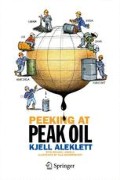Abstract
At the start of the new millennium, the expression “Peak Oil” was unknown. Nevertheless, a discussion about when the world’s rate of oil production would reach its maximum had already begun when the geologist M. King Hubbert presented his model for future oil production in the United States in the 1950s. At that time, Hubbert worked for the Shell Company and his model was discussed for the first time at a conference organized by the American Petroleum Institute (API) from the 7th to the 9th of March 1956 at the Plaza Hotel in San Antonio, Texas.
Access this chapter
Tax calculation will be finalised at checkout
Purchases are for personal use only
References
King Hubbert, M.: Nuclear Energy and the Fossil Fuels, Shell Development Company, Exploration and Production Research Division, Houston, TX, Publication No. 95, 1956. http://www.energybulletin.net/node/13630 (1956)
Ronald, E.D.: Interview with Dr. M. King Hubbert, Jan 4–6, 1989. Niels Bohr Library and Archives. http://www.aip.org/history/ohilist/5031_1.html (1989)
Nashawi, I.S., Malallah, A., Al-Bisharah, M.: Forecasting world crude oil production using multicyclic Hubbert model. Energy Fuels 24, 1788–1800 (2010)
Stanley, B.: Oil Experts Draw Fire for Warning. Associated Press, May 24, 2002. http://www.semissourian.com/story/75282.html (2002)
ASPO, The Association for the Study of Peak Oil and Gas. http://www.peakoil.net (2012)
BP: BP Statistical Review of World Energy, June 2011. http://bp.com/statisticalreview (historical data; http://www.bp.com/assets/bp_internet/globalbp/globalbp_uk_english/reports_and_publications/statistical) (2011)
WEO: World Energy Outlook 2010. International Energy Agency, November 2010. http://www.worldenergyoutlook.org/2010.asp (2010)
Since available data on the energy from oil, coal and gas are given in thermal energy units, the volumes of energy available from hydro, nuclear, and other renewables are converted on the basis of thermal equivalence assuming a 38% conversion efficiency as in a modern thermal power station (2010)
International Energy Agency: Oil Market Report 15 March 2011, April 11, 2011. http://omrpublic.iea.org/omrarchive/15mar11full.pdf (2011)
U.S. Energy Information Administration: Petroleum and Other Liquids, World Oil Balance. http://www.eia.gov/emeu/ipsr/t21.xls (2011)
Author information
Authors and Affiliations
Corresponding author
Rights and permissions
Copyright information
© 2012 Springer Science+Business Media New York
About this chapter
Cite this chapter
Aleklett, K. (2012). Peak Oil. In: Peeking at Peak Oil. Springer, New York, NY. https://doi.org/10.1007/978-1-4614-3424-5_2
Download citation
DOI: https://doi.org/10.1007/978-1-4614-3424-5_2
Published:
Publisher Name: Springer, New York, NY
Print ISBN: 978-1-4614-3423-8
Online ISBN: 978-1-4614-3424-5
eBook Packages: Earth and Environmental ScienceEarth and Environmental Science (R0)

